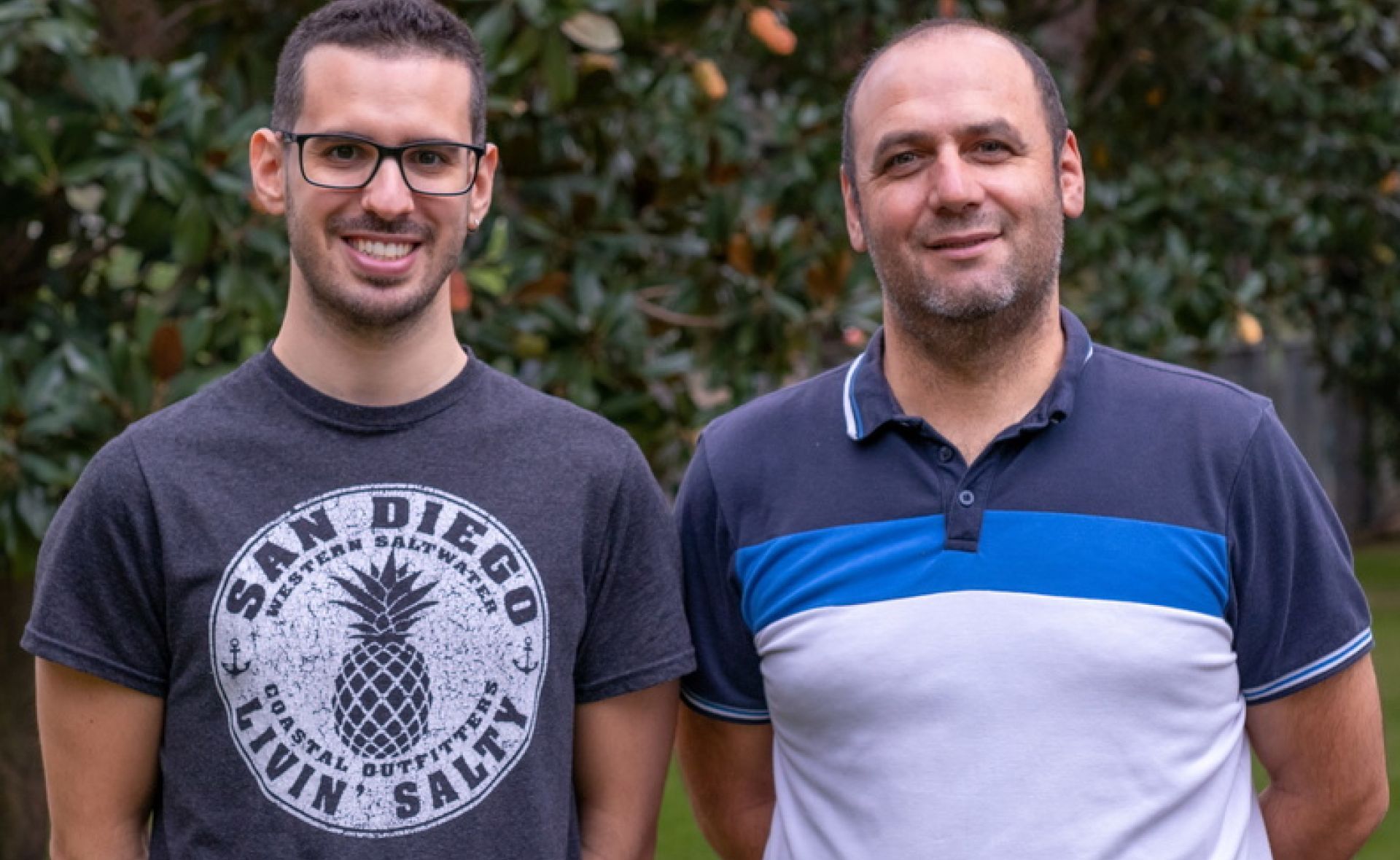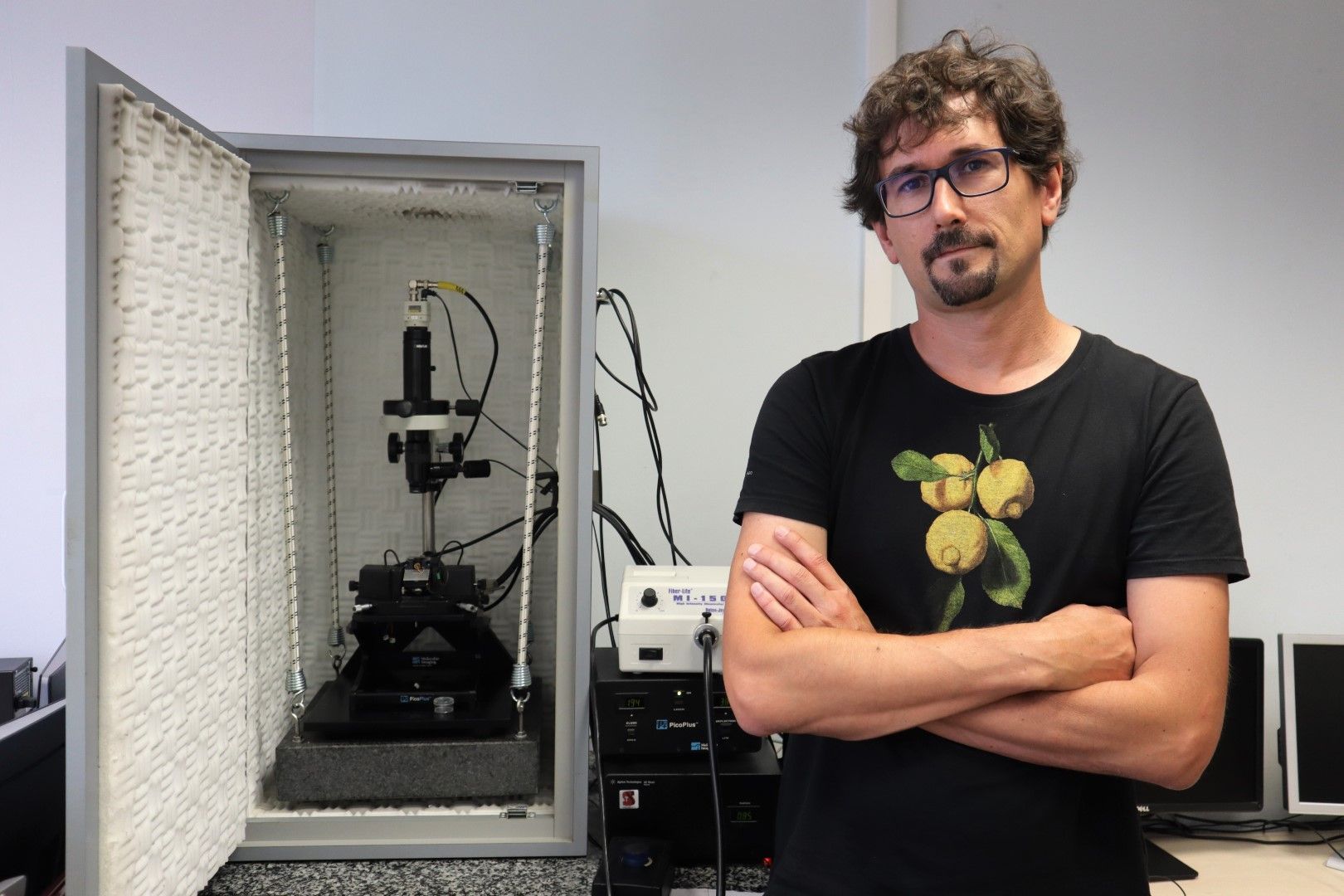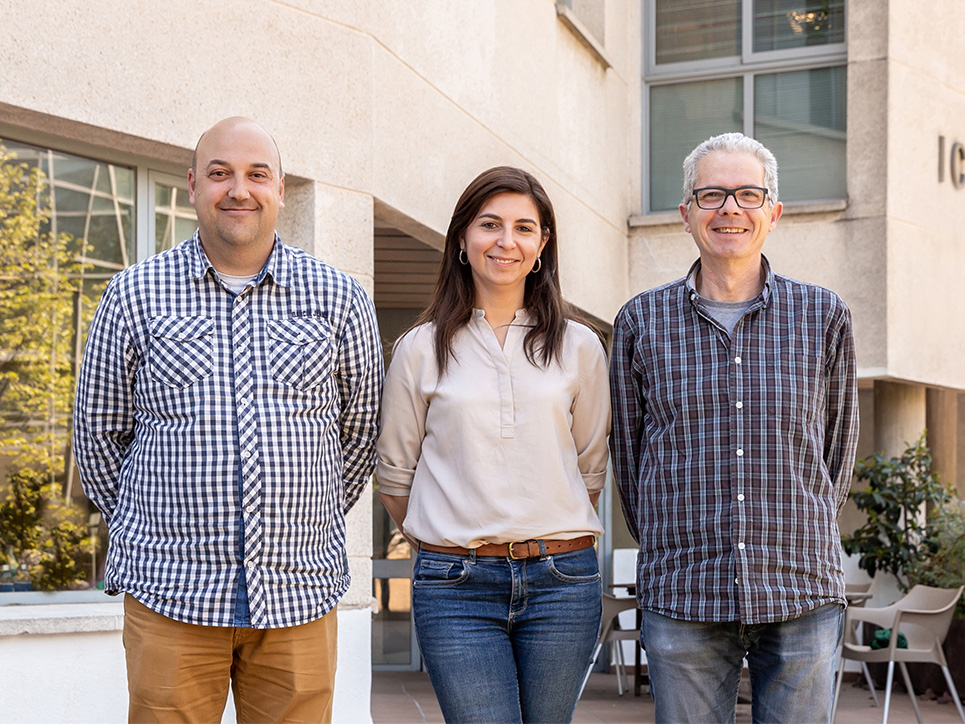Scientific & Technical Services
Scientific & Technical Services

Bioservice

Low Temperatures and Magnetometry
The main duty of the Low Temperatures and Magnetometry Service is the characterization of magnetic and electric transport techniques as a function of temperature and magnetic field. Those techniques include magnetization, AC Susceptibility, resistivity, magneto-resistance, Hall effect and IV Characteristics.
The equipment present at the Service includes:
- 1 Quantum Design MPMS-XL Magnetometer
- 1 Quantum Design MPMS3 Magnetometer
- 2 Quantum Design PPMS
- 1 ICE-Oxford Cryostat
These equipments allow exploring those material properties under a wide range of temperatures (1.5K-400K) and magnetic field (up to 160kOe).

MBE: Laboratory of Molecular Beam Epitaxy
The L-MBE is always operated in self-service mode backed up by the expert users, Dr. M. Garriga and Dr. M. I. Alonso. In 2024, the equipment was used in projects connected to three research subjects in the “NANOPTO” group. The service time was divided among research in photonic structures based on high refractive index materials (Si, Ge), thin Ge films for thermal transport studies, and Si structures for harvesting infrared solar energy.

Nanoquim Platform
Nanoquim Platform is a 10000 class cleanroom (ISO7) that belongs to the ICMAB’s Scientific & Technical Services The facility is equipped with over 30 physico-chemical equipments that allow
researchers develop a variety of processes related with:
- Controlled growth of nanomaterials, physical and chemical deposition, selective etching of layers or compounds
- Chemical synthesis
- Device fabrication
- Characterization of nanomaterials
- Photolitography
In a low-particle index environment and controlled humidity and temperature conditions.
Total experiment: 2230
Public center: 14
Private center: 7
PRUAB: 11

SEM-TEM: Electron Microscope Service
The electron microscopy service is equipped with a transmission electron microscope (TEM) JEM1210 (JEOL) , scanning electron microscope (SEM) QUANTA FEI 200 FEG-ESEM and optical microscope (MO) Olympus BX51, which are operated by two technicians who serve internal and external users.
In 2024, the following internal service have been carried out: 403.5 hours of TEM, 1160 hours of SEM and 201.2 hours of MO service. In addition, the following external service were carried out: TEM (23 hours) and SEM (92 hours). Public institutions and private companies have received it, including the following: Dept. De Biologia de Sistemas (Universidad de Alcalá), Universidad Politécnica de Catalunya (Ciencia i Enginyeria de Materials), Dept. Geologia (Universitat Autònoma de Barcelona), Centro Nacional de Microelectrónica (IMB-CNM), Carburos Metálicos (Grupo Air Products), Mapa Spontex Iberica-Newel Brands, Fundaçao Universidade Federal de Sao Carlos (Brasil), Duke Chem, Abezeta Sau, Gentec.
The service has contributed to 30 scientific publications and has actively participated in numerous science outreach activities, including the Programa Argó (UAB, 25/06/2024–11/07/2024), as well as several educational visits from primary and secondary school students. These include visits from students of Salle de Manlleu School, Ramar 2 School (Sabadell), Institut La Romànica (Barberà del Vallès), and students from the UAB.

SOFT: Preparation and Characterization of Soft Materials
In the Soft Materials Service, users can perform their experiments assisted by technicians or as auto-service. The service usage is split between 26 PIs from ICMAB, 52 external research groups from other research facilities and universities and 14 external companies.
PROJECTS
- COAT-IT, “Prevenció de les infeccions dels dispositius electrònics implantables cardíacs mitjançant l'ús d'un recobriment bimodal basat en un hidrogel activable tèrmicament amb antimicrobians d’ampli espectre” (202326-32), Fundació La Marató de TV3, 22/04/2024-21/04/2027.
- BRIGHT-GUIDE, “Ultrabright fluorescent agent for image guided surgery in cancer” (2024 PROD 00075), AGAUR, 02/12/2024-01/06/2026.
- Armonia, “Nanoarquitectonica para crear nuevos nanomateriales moleculares para aplicaciones biomédicas”, (PID2022-137332OB-I00), AEI-Ministerio de Ciencia e Inovación, 01/08/2023-31/08/2026.
- PHASOL, “Experimental development of two complementary technologies to produce particulate solid forms of active pharmaceutical ingredients” (CPP2022-010004), AEI Ministerio de Ciencia, Inovación y Universidades, 01/12/2023-30/11/2026.
- Phoenix “Pharmaceutical Open Innovation Test Bed for Enabling Nano-pharmaceutical Innovative Products” (953110), European Commission, 01/03/2021-28/02/2025.
- Micro4Nano, Multifunctional nanocarriers for nonlinear microscopy: new tools for biology and medicine (101007804), European Commission, 01/10/2021-30/09/2026.
- NABIHEAL, “Antimicrobial Nanostructured Biomaterials for Complex Wound Healing” (101092269), European Commission, 01/01/2023-31/12/2026.
- GreenX3, “Innovative and sustainable materials, processes and technologies for a greener and circular economy” (101120061), European Commission, 1/09/2023-31/08/2027.
THESIS
- Aida Carreño: “Advanced characterization of alpha-galactosidase nanoliposomal formulations for fabry disease treatment” supervised by Nora Ventosa, Jose Luis Corchero and Elisabet González at 23/02/2024, Universitat Autònoma de Barcelona (UAB).
- Xavier Rodríguez: “Functional nanostructured molecular materials for antimicrobial and biosensing applications” supervised by Imma Ratera and Judith Guasch at 28/06/2024, Universitat Autònoma de Barcelona (UAB).
- Marta Alcaina: “A new plant-based nanovesicle platform based on alkyl polyglucosides and β‑sitosterol for topical delivery” supervised by Nora Ventosa and Alba Córdoba (Nanomol-Technologies SL) at 20/09/2024, Universitat Autònoma de Barcelona (UAB).
- Carla Castellar: “DELOS Nanovesicles for the Subcutaneous and Oral Delivery of Challenging-to-Formulate Compounds” supervised by Elisabet González and Lidia Ferrer (Nanomol-Technologies SL) at 04/10/2024, Universitat Autònoma de Barcelona (UAB).
ARTICLES
- Alcaina-Hernando M, Malvacio I, Ferraboschi I, Huck-Iriart C, Bianchera A, Sala S, Pedersen JS, Ferrer-Tasies L, Pescina S, Sissa C, Ventosa N, Córdoba A, A new plant-based drug delivery platform based on alkyl polyglucosides and β-sitosterol nanovesicles for topical delivery, Applied Materials Today, 2024, 41, 102467, doi: 10.1016/j.apmt.2024.102467.
- Tomsen-Melero J, Moltó-Abad M, Merlo-Mas J, Díaz-Riascos ZV, Cristóbal-Lecina E, Soldevila A, Altendorfer-Kroath T, Danino D, Ionita I, Pedersen JS, Snelling L, Clay H, Carreño A, Corchero JL, Pulido D, Casas J, Veciana J, Simó Schwartz Jr, Sala S, Font A, Birngruber T, Royo M, Córdoba A, Ventosa N, Abasolo I, González-Mira E. Targeted nanoliposomes to improve enzyme replacement therapy of Fabry disease. Science Advances, 2024, 10(50), 4738. doi: 10.1126/sciadv.adq4738
WORKSHOPS
- ICMAB technical seminar called: “Characterization techniques for particulate materials”, from 07/10/2024-09/10/2024.

SPM: Scanning Probe Microscopy Laboratory
The SPM lab offers surface characterization by SPM related experiments both to the ICMAB community and to external users (researchers and companies).
During 2024 the service has supplied atomic force microscopy data to 13 ICMAB research groups, 6 external research groups and 3 companies. The service has contributed to improve the topographic characterization of variety of systems including organic and inorganics surfaces. Advanced surface properties characterization such as mechanical, electrostatic, conductive and magnetic have been also performed in particular samples of interest. In addition, the service has worked closely with researchers to develop more advanced modes according to their needs.
The service has also participated in different outreach activities such as the Programa Argó of Universitat Autònoma de Barcelona (UAB).
The techniques offered by the service include:
- Atomic force microscopy (AFM) in ambient and N2 atmosphere.
- Contact mode
- Tapping mode
- Non-contact mode
- Friction force microscopy
- Electrostatic force microscopy (EFM)
- Kelvin probe force microscopy (KPFM)
- Piezoresponse force miscroscopy (PFM)
- Magnetic force microscopy (MFM)
- PinPoint AFM
- Scanning tunnelling microscopy (STM) in ambient conditions
- Constant current mode
The equipment present at the service is:
- Park System NX10
- Keysight 5500 AFM

STL: Spectroscopic Techniques Laboratory
The spectroscopy service consists of four instruments:
- The Fourier-transform infrared spectrophotometer (FT-IR) Jasco 4700LE – Operates within a range of 400 to 7800 cm⁻¹.
- Two ultraviolet-visible-near-infrared (UV-Vis-NIR) spectrophotometers:
Jasco V-770 – Covers a wavelength range from 190 to 3200 nm.
Jasco V-780 – Covers a range from 190 to 1600 nm and includes an integrating sphere for measuring solid samples with internal diffuse reflectance accessory.
Both spectrophotometers offer a temperature range of 0 to 100°C for liquid samples and can measure semi-transparent films or substrates.
- Electron Paramagnetic Resonance (EPR) ELEXSYS E500 – Suitable for measuring liquid samples (within a temperature range of 400 to 120 K) and solid samples (either powder or substrates).
Equipment Usage in 2024:
FT-IR: it recorded a total of 432 usage entries in 2024. Approximately 60 users from 19 different principal investigators (PIs) at ICMAB have accessed this equipment.
UV-Vis-NIR (V-770 and V-780): The V-770 recorded 406 entries, while the V-780 recorded 374 entries. Both instruments were used by around 60 users from 25 different PIs at ICMAB, as well as two external research groups.
EPR: it logged 70 entries in 2024, with 10 users from 5 different PIs at ICMAB, as well as one external collaboration.
Additionally, the service has been involved in a national research project and has contributed to the publication of several scientific articles. It also participated in the ICMAB Christmas gymkhana of the scientific-technical services.

Thermal Analysis Laboratory
The Thermal Analysis Lab is formed by Thermal Analysis Service and Surface Area Analysis Service. The Thermal Analysis Service the service has at its disposal two TGA (thermogravimetric analysis), ONE OF THIS WITH A COUPLED MASS SPECTROMETER and one DSC (differential scanning calorimetry). The Surface Area Analysis has one Brunauer–Emmett–Teller (BET). During the 2024 Regarding the TGA, we analyzed a total of 167 samples, 63 % of them belong to internal users from the ICMAB, and 37 % from external users. The DSC equipment has been used to analyse 116 samples, 60% belong to internal users and 40% to external users. The service has participated in the Programa Argó with UAB during the year.
Some publications:
Ca2+ Electrochemical Intercalation in Fe[Fe(CN)6]1–y Berlin Green, Alejandro Ramo-IrurreCarlos FronteraAshley P. Black*M.Rosa Palacin*, Energy Mater. 2025, 8, 1, 31–35
https://pubs.acs.org/doi/10.1021/acsaem.4c02623
Thermal Stability and Purity of Graphene and Carbon Nanotubes: Key Parameters for Their Thermogravimetric Analysis (TGA), Markus Martincic,Stefania SandovalORCID,Judith Oró-SoléORCID andGerard Tobías-Rossell *, Nanomaterials 2024, 14(21), 1754
https://doi.org/10.3390/nano14211754
UV-Vis quantification of the iron content in iteratively steam and HCl purified single-walled carbon nanotubes, Markus Martincic,Gerard Tobías-Rossell, PLoS ONE 19(5): e0303359
https://doi.org/10.1371/journal.pone.0303359
Photon upconversion crystals doped bacterial cellulose composite films as recyclable photonic bioplastics, Bharmoria P.*, Naimovičius L., Abol-Fotouh D., Miroshnichenko M., Lekavičius J., De Luca G., Saeed U., Kazlauskas K., Candau N., Baronas P., Roig A. & Moth-Poulsen K.*, Communications Materials. DOI:10.1038/s43246-024-00638-6
In situ shaping of intricated 3D bacterial cellulose constructs using sacrificial agarose and diverted oxygen inflow, Abol-Fotouh D., Al-Hagar O.E.A., Roig A.*, Carbohydrate Polymers, vol. 343, art. 122495. DOI:10.1016/j.carbpol.2024.122495
Unlocking the Potential of Wood Residues for Producing ScreenPrinted Electrochemical Sensors, Duan W., González A., Gich M.*, Fernández-Sánchez C.*, ACS Sustainable Chemistry and Engineering, vol. 12, iss. 11, p. 4386−4397. DOI:10.1021/acssuschemeng.3c06775

Thin Films Laboratory
The tecniques of Pulsed Laser Deposition (PLD) and DC Magnetron Sputtering are available at the service of Thin Films. PLD has been extensively used, mostly for epitaxial growth of complex oxides with varied functionality as ferroelectricity, ferromagnetism, superconductivity, etc.
Complex epitaxial heterostructures combining different functional oxides have been also fabricated. The Service has also integrated epitaxial oxides with silicon wafers. Some processes have involve the use of reflection high-energy electron diffraction, either in real time or as post deposition characterization.
Sputtering has been also widely used, either for epitaxial growth of metals or for deposition of top metallic electrodes, using generally stencil masks.

X-ray Diffraction Laboratory
In 2024, 4030 samples (amounting a total of 4497 hours) were analyzed by the XRD Service. The principal users were the research groups of Superconducting Materials and Large Scale Nanostructures, Crystallography, Ferroelectric oxide films for energy and memory devices, Solid State Chemistry, Nanoparticles & Nanocomposites, Multifunctional Thin Films and Complex Structures, Advanced Structural and Functional Characterization and the Smart Molecular Inorganic and Hybrid.
The external users during 2024 include companies: Nanomol Technologies, Applus, and other research centers (CNM, UAB).
The XRD service has played an active role in many science education activities including the visit of primary and high schools with interactive experiments to increase their interest and curiosity in science and technology.
Last year the XRD service attended and participate in the “18th European Powder Diffraction Conference” congress in Padova (Italy) and “7ª Reunión de Personal Técnico y Responsables de Difracción” meeting in Málaga.
The service has participated in many publications and projects of the center:
Metal Propionate Solutions for High-Throughput Liquid-Assisted Manufacturing of Superconducting REBa2Cu3O7-δ (RE = Y, Gd, Sm, and Yb) Films. L. Saltarelli, D. Sanchez-Rodriguez, K. Gupta, A. Kethamkuzhi, J. Farjas, E. Molins, R. Yañez, S. Ricart, X. Obradors and T. Puig. ACS Applied Materials & Interfaces 16, 54199–54214 (2024)
Tan, A. Quintana, N. Dix, S. Estandía, J. Sort, F. Sánchez, and I. Fina, Photovoltaic-driven dual optical writing and non-destructive voltage-less reading of polarization in ferroelectric Hf0.5Zr0.5O2 for energy efficient memory devices. Nano Energy 123 (2024). (https://doi.org/10.1016/j.nanoen.2024.109384)